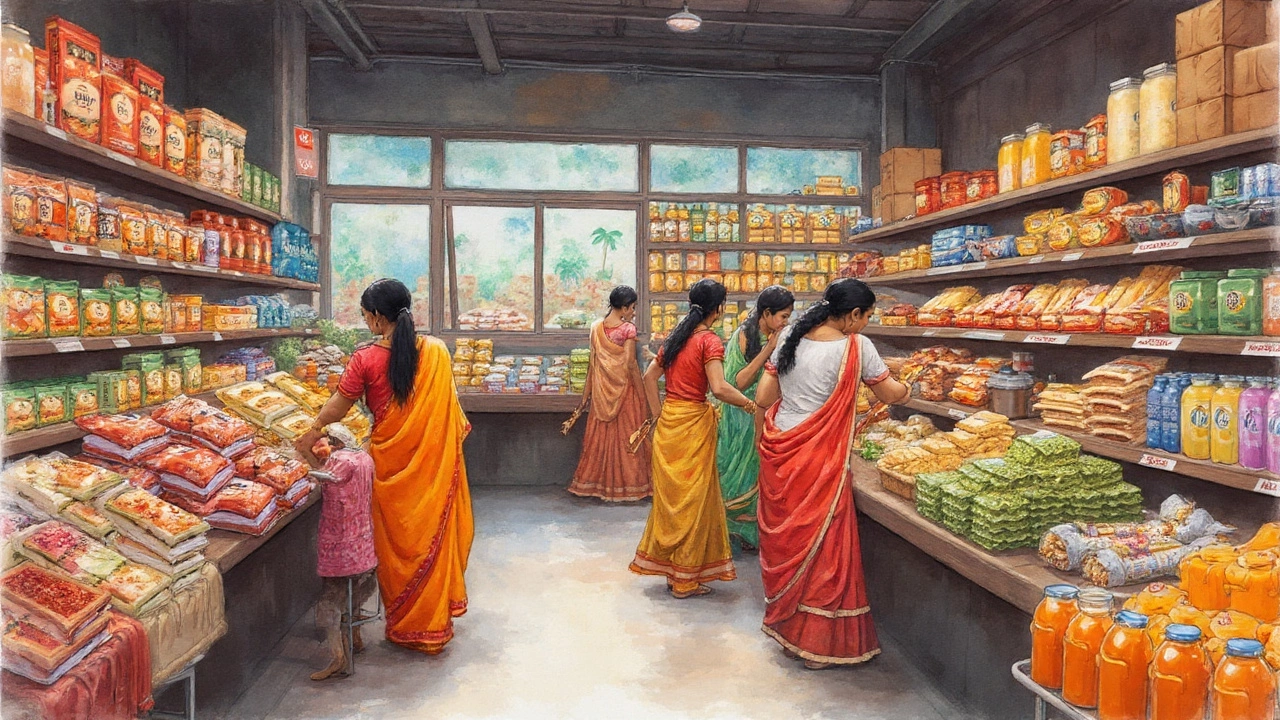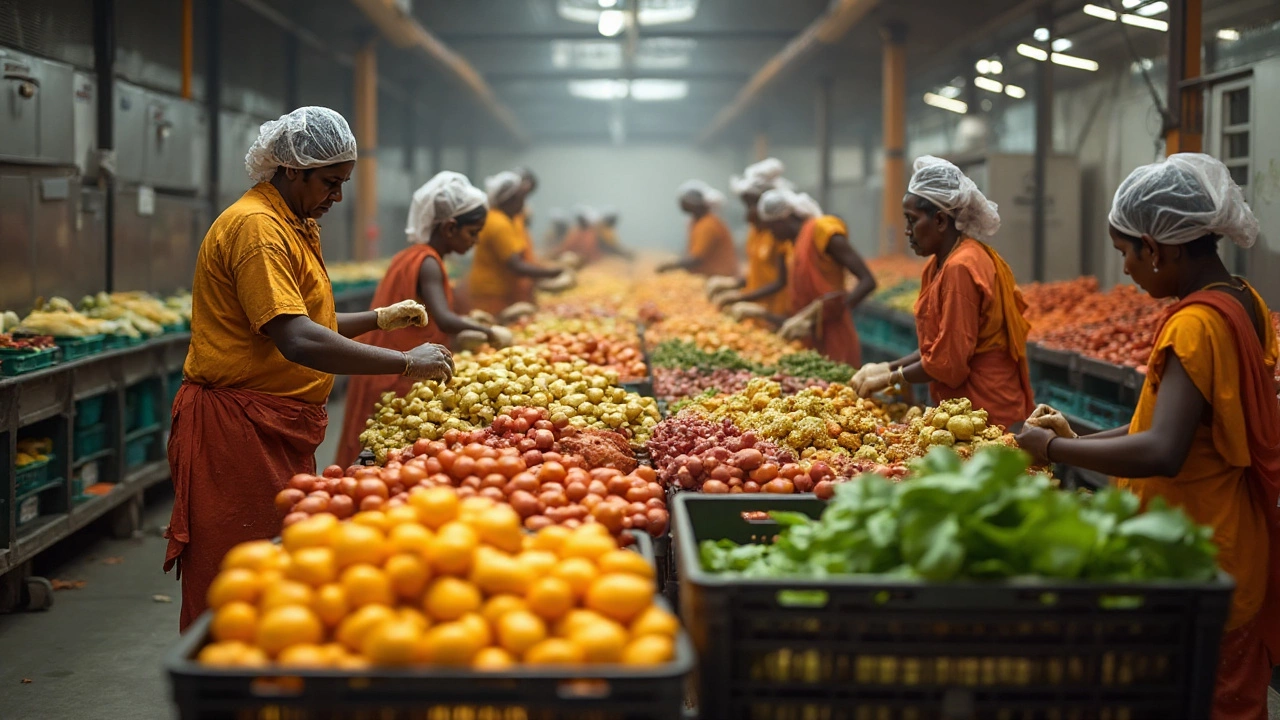Grab a snack and look at the label. Chances are, every little ingredient tells a story that started in some hidden corner of the food processing world. It’s wild to think that everything from your favorite frozen pizza to a can of chickpeas made the same journey—from raw, perishable stuff to something you trust to eat. Food processing is less about mysterious machines and more about clever innovation, quality control, and relentless hygiene standards that keep us healthy and fed. Get this—India alone ranks among the top five food processing countries, juggling tons of spices, rice, dairy, juices, sweets, and so much more. This is no small potatoes; food processing is one of the most diverse industries on the planet.
Major Sectors Shaping the Food Processing Landscape
Let’s break down the maze of food processing into fields that truly matter. If you open your kitchen cupboard, it’s a treasure chest of processed foods: some shelf-stable, some chilled, a few that just need a zap in the microwave. Each food group has an entire industry behind it.
Food processing fields are usually categorized into these core sectors:
- Cereal and Grain Processing – Think: flour, bread, breakfast cereals, noodles. That bag of chips? Corn or potato, both processed for taste and crunch.
- Dairy Processing – All that milk gets turned into cheese, butter, ghee, yogurt, and, yes, those milkshakes you crave.
- Meat, Poultry & Seafood Processing – From packaged fresh cuts to sausages, nuggets, smoked salmon, and even fish fingers.
- Fruit & Vegetable Processing – Tomato ketchup, jams, pickles, canned pineapple rings, frozen peas—so many formats exist just to keep these foods edible year-round.
- Beverages – Bottled water, soft drinks, fruit juices, energy drinks, and even the humble tea bag all come from their own dedicated sub-sectors.
- Bakery & Confectionery – Cookies, biscuits, cakes, chocolates—you know this aisle too well.
- Ready-to-Eat (RTE) & Convenience Foods – Instant noodles, heat-and-eat curries, microwavable rice, frozen pizzas. Perfect for late-night cravings or quick school tiffins.
- Oils & Fats Processing – Cooking oil, margarine, vanaspati, ghee; you can’t whip up a meal without this.
- Spices, Sauces & Condiments – Turmeric powder, curry pastes, ketchup, soy sauce, mayonnaise; these small bottles pack global flavors.
Each of these fields goes beyond just packaging food. For example, dairy processing doesn’t stop at pasteurizing milk. It involves multiple processes like fermentation (for yogurt and cheese), refrigeration, and spraying techniques to make milk powder. Meanwhile, grain processing might deploy air classification machines to separate finer flour grades, or high-tech belt dryers that churn out crunchy cereals.
India processes about 10% of its fruits and vegetables, which is actually pretty low. Countries like the US process up to 70%—showing why shelves there look so different. Indian companies like Amul, Parle, and ITC dominate certain fields, driving the country’s Rs 6.54 lakh crore (over $80 billion) market. And with more urban consumers craving convenience, ready-to-eat foods and snacks have seen a 15% spike year-on-year, as per FICCI’s 2024 Food Report.
Here’s a quick look at how major fields stack up in terms of processing volumes across the globe:
| Field | Global Market Share (2024, % approx.) | Key Example Products |
|---|---|---|
| Cereal & Grain | 21% | Bread, noodles, ready-to-eat breakfast |
| Dairy | 16% | Milk powder, cheese, yogurt |
| Meat/Seafood | 11% | Packed chicken, sausages, fish fingers |
| Fruit & Vegetable | 10% | Canned pineapple, frozen peas, jam |
| Ready-to-Eat | 8% | Instant noodles, frozen pizza |
| Beverages | 17% | Juices, water, soft drinks |
| Bakery & Confectionery | 7% | Cakes, biscuits, chocolate |
| Oils & Fats | 5% | Cooking oil, ghee, margarine |
| Spices, Sauces | 5% | Ketchup, soy sauce, curry paste |
So, why does food processing exist? Simple. It extends shelf life, ramps up food safety, and slashes wastage. In India, over 25% of harvested fruit and veggies rot before reaching consumers because of poor infrastructure. Enter—processing. Suddenly, perishable mangoes become all-year mango pulp and lassi.
Something most folks overlook: Every field has its tech — pasteurization in dairy, freeze-drying in instant coffee, MAP (Modified Atmosphere Packaging) in snacks, and aseptic packing for tetra-pak drinks. Each field is an industry by itself.
If you’re ever thinking about entering the food processing game, remember: There’s niche in every field—lots of room for creative brands, new-age snacks, healthy innovations, or even plant-based foods if you’re up for it.

How Technologies Transform Traditional Food Processing
Nobody processes food the way they did twenty years ago. Each field faces a tech upgrade—faster, safer, and with less waste. Let’s get into how gadgets and digital brains have changed things for good.
Start with automation. In every recognized factory, conveyor belts bob with cookies, veggies, chicken wings, or dough. Indian factories are now racing to match their Western counterparts with robotic packing arms and vision systems that spot bad fruit faster than any human.
Look at dairy again—everybody's heard about pasteurization, but you have ultra-high temperature (UHT) processing now, too. It lets milk sit on shelves for six months, unopened. No fridge? No problem. The moment you open that pack, however, your race against time starts—just like when grandma boiled milk.
How about grain? Roller milling is ancient news; now, it’s about micronization and cryogenic grinding, which keeps spices more flavorful and keeps you sneezing less in the kitchen. India's masala market alone spiked to $4 billion in 2023 due to such upgrades.
Meat and seafood processing saw even bigger leaps. Flash-freezing lets sushi-grade tuna make it from Japan to your plate safely. And lately, plant-based protein alternatives have started crowding cold storage next to real meat, all because of extrusion tech that recreates the texture of chicken or mutton.
There’s a buzz in snacks, too. Ever heard of MAP? It pumps nitrogen into chip bags, pushing out oxygen, stopping that awful stale taste. And in ready-to-eat meals, retort processing locks in taste and nutrients for months—so you’ll spot a ready dal or biriyani pouch labeled with “no preservatives” and actually believe it.
- AI Monitoring: Factories use sensors to track temperature, humidity, and hygiene. Real-time feedback means less human error and fewer batch rejections.
- Enzyme Technology: Used for clearer juices, consistent yogurts, non-bitter jams. One enzyme can make the difference between success and waste.
- Biodegradable Packaging: The big push worldwide is to ditch plastics and use plant-based films made from starch or cellulose. In 2024, companies like Tetra Pak and India’s UFlex ramped up production of recyclable, compostable options.
- BlockChain & QR Codes: You can now scan a pack of organic rice and see its journey from farm to fork. This builds trust for export brands and consumers, reducing fake products.
Not every innovation makes headlines. For example, “cold plasma technology” recently rolled out trials in the spice export sector. By zapping food with ionized air, it kills microbes—making it a game-changer for preserving spices without weird chemicals.
These little leaps mean less spoilage, safer food, and more variety. Take microwave dehydration. Before it caught on, dried fruits tasted chewy or weird. Now, you get crunchy apples or banana chips with far less oil. Add to that: solar dryers used by small farmers, or laser sorting machines used by global giants, all blend age-old wisdom with shiny tech.
People think food processing is just about keeping food longer, but these tools actually keep what’s inside better—vitamins, color, local taste. You’re eating better because someone, somewhere, got obsessive about making machines smarter and safer. No gadget is too small either; some new home-scale dehydrators or fermentation kits let regular people experiment with mini processing fields in their own kitchens.

Troubleshooting, Trends, and Tips for Getting Food Processing Right
Here’s where it gets personal. Food processing isn’t just big companies, giant machinery, and glossy ads. It’s also home kitchens, village clusters, down-to-earth entrepreneurs, and even students tinkering with healthy recipes. For anyone who wants to get into food processing—small or large—the real struggle is handling change, costs, and the occasional disaster batch.
The food industry faces stubborn trouble spots. Food spoilage is every processor’s nightmare; so are shifting consumer expectations. In a world hungry for health and freshness, “processed” sometimes gets a bad rap. The best advice? If you’re making something—at home or commercially—focus hard on hygiene, ingredient quality, and avoiding shortcuts. That’s actually where most startups trip up.
Then there’s climate risk. Scorching summers melt chocolates, floods ruin grain shipments, and power cuts threaten refrigeration. That’s why companies diversify—think frozen, dried, canned, and vacuum-packed options. Even a home processor can freeze, pickle, or dry mangoes to ensure a steady snack year-round.
If you’re looking at trends, plant-based everything continues its stampede. Oat milk, tofu nuggets, quinoa burgers—if you see them in your local grocery, thank innovators in both R&D and marketing. In India, millet-based snacks are finding their way into international supermarkets thanks to processing tech that masks bitterness and boosts crunch.
Packaging deserves its spotlight too. Shrinking pack sizes to fit city homes, QR codes for instant recipe ideas, or even travel-friendly tetra packs for picnics—all are growth hacks in disguise.
Here’s a hit-list of tips if you’re planning to dabble in food processing, whether as a full business or side hustle:
- Start small—pick one field, get obsessed with quality, and scale up without cutting corners.
- Keep learning. Food laws (like FSSAI in India or FDA in the US) change every year; stay updated or risk shutdowns and penalties.
- Embrace local trends. A masala mix that’s hot in Tamil Nadu may flop in Delhi, and vice versa. Test markets.
- Think seasonally. Extend the mango season by freezing or pulping surplus crops—the same logic goes for veggies post-harvest.
- Watch shelf life. Anything with high moisture has a short window; invest in dehydration, refrigeration, or preservatives only if needed.
- Always check your math. Profits depend on efficiency—a 3% loss in raw cashews can erase your margins, so watch every step and count your pennies.
Success stories don’t always look the same. Giant firms like Nestlé, ITC, or Amul make global headlines, but so do family pickling businesses and farmer co-ops. In 2023, a small startup in Pune found gold by freeze-drying kokum fruit for urban teas—a formerly unglamorous home remedy turned health trend, all thanks to one smart machine.
Pay attention to government schemes. State subsidies and the Production Linked Incentive (PLI) for Food Processing offer a lifeline for new investments, cold chains, and exports in India. If you know where to look, even a college grad can apply for soft loans to pilot a jam business or cold-pressed oil unit.
Master the basics: sanitation, up-to-date licenses, reliable power backup, and eye-catching packaging. Throw in a clever twist, whether gluten-free bread or vegan ice cream, and you might just find your niche.
Food processing isn’t a mysterious craft—it’s a blend of smart science, crazy ingenuity, and a knack for making everyday meals feel fresh, safe, and just a bit special all year round. So, when you bite into your next snack or pour a glass of juice, you’ll know exactly how deep and wide this world really is.
